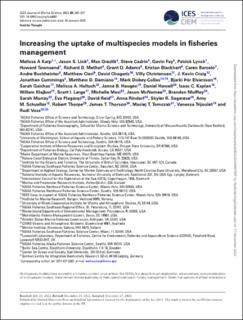| dc.contributor.author | Karp, Melissa A | |
| dc.contributor.author | Link, Jason S | |
| dc.contributor.author | Grezlik, Max | |
| dc.contributor.author | Cadrin, Steve | |
| dc.contributor.author | Fay, Gavin | |
| dc.contributor.author | Lynch, Patrick | |
| dc.contributor.author | Townsend, Howard | |
| dc.contributor.author | Methot, Richard D | |
| dc.contributor.author | Adams, Grant D | |
| dc.contributor.author | Blackhart, Kristan | |
| dc.contributor.author | Barceló, Caren | |
| dc.contributor.author | Buchheister, Andre | |
| dc.contributor.author | Cieri, Matthew | |
| dc.contributor.author | Chagaris, David | |
| dc.contributor.author | Christensen, Villy | |
| dc.contributor.author | Craig, J. Kevin | |
| dc.contributor.author | Cummings, Jonathan | |
| dc.contributor.author | Damiano, Matthew D | |
| dc.contributor.author | Dickey-Collas, Mark | |
| dc.contributor.author | Elvarsson, Bjarki Þór | |
| dc.contributor.author | Gaichas, Sarah | |
| dc.contributor.author | Haltuch, Melissa A | |
| dc.contributor.author | Haugen, Janne B | |
| dc.contributor.author | Howell, Daniel | |
| dc.contributor.author | Kaplan, Isaac C | |
| dc.contributor.author | Klajbor, Willem | |
| dc.contributor.author | Large, Scott I | |
| dc.contributor.author | Masi, Michelle | |
| dc.contributor.author | McNamee, Jason | |
| dc.contributor.author | Muffley, Brandon | |
| dc.contributor.author | Murray, Sarah | |
| dc.contributor.author | Plagányi, Éva | |
| dc.contributor.author | Reid, David | |
| dc.contributor.author | Rindorf, Anna | |
| dc.contributor.author | Sagarese, Skyler R | |
| dc.contributor.author | Schueller, Amy M | |
| dc.contributor.author | Thorpe, Robert | |
| dc.contributor.author | Thorson, James T | |
| dc.contributor.author | Tomczak, MacIej T | |
| dc.contributor.author | Trijoulet, Vanessa | |
| dc.contributor.author | Voss, Rudi | |
| dc.date.accessioned | 2023-11-20T08:43:35Z | |
| dc.date.available | 2023-11-20T08:43:35Z | |
| dc.date.created | 2023-05-09T14:31:03Z | |
| dc.date.issued | 2023 | |
| dc.identifier.citation | ICES Journal of Marine Science. 2023, 80 (2), 243-257. | |
| dc.identifier.issn | 1054-3139 | |
| dc.identifier.uri | https://hdl.handle.net/11250/3103464 | |
| dc.description.abstract | Multispecies models have existed in a fisheries context since at least the 1970s, but despite much exploration, advancement, and consideration of multispecies models, there remain limited examples of their operational use in fishery management. Given that species and fleet interactions are inherently multispecies problems and the push towards ecosystem-based fisheries management, the lack of more regular operational use is both surprising and compelling. We identify impediments hampering the regular operational use of multispecies models and provide recommendations to address those impediments. These recommendations are: (1) engage stakeholders and managers early and often; (2) improve messaging and communication about the various uses of multispecies models; (3) move forward with multispecies management under current authorities while exploring more inclusive governance structures and flexible decision-making frameworks for handling tradeoffs; (4) evaluate when a multispecies modelling approach may be more appropriate; (5) tailor the multispecies model to a clearly defined purpose; (6) develop interdisciplinary solutions to promoting multispecies model applications; (7) make guidelines available for multispecies model review and application; and (8) ensure code and models are well documented and reproducible. These recommendations draw from a global assemblage of subject matter experts who participated in a workshop entitled “Multispecies Modeling Applications in Fisheries Management”. | |
| dc.language.iso | eng | |
| dc.title | Increasing the uptake of multispecies models in fisheries management | |
| dc.title.alternative | Increasing the uptake of multispecies models in fisheries management | |
| dc.type | Peer reviewed | |
| dc.type | Journal article | |
| dc.description.version | publishedVersion | |
| dc.source.pagenumber | 243-257 | |
| dc.source.volume | 80 | |
| dc.source.journal | ICES Journal of Marine Science | |
| dc.source.issue | 2 | |
| dc.identifier.doi | 10.1093/icesjms/fsad001 | |
| dc.identifier.cristin | 2146492 | |
| cristin.ispublished | true | |
| cristin.fulltext | original | |
| cristin.qualitycode | 2 | |
